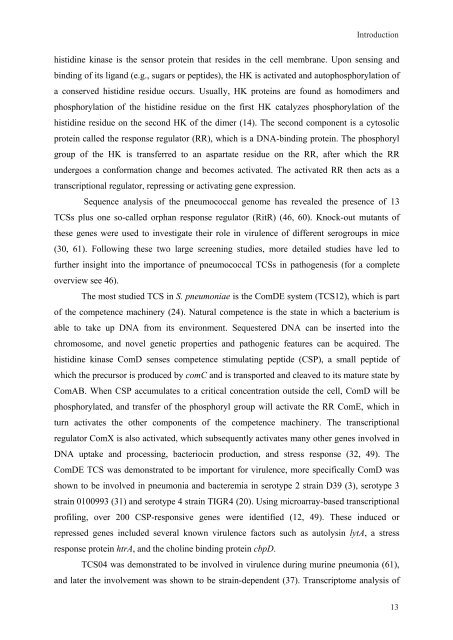Gene regulation in Streptococcus pneumoniae - RePub - Erasmus ...
Gene regulation in Streptococcus pneumoniae - RePub - Erasmus ...
Gene regulation in Streptococcus pneumoniae - RePub - Erasmus ...
Create successful ePaper yourself
Turn your PDF publications into a flip-book with our unique Google optimized e-Paper software.
histid<strong>in</strong>e k<strong>in</strong>ase is the sensor prote<strong>in</strong> that resides <strong>in</strong> the cell membrane. Upon sens<strong>in</strong>g and<br />
b<strong>in</strong>d<strong>in</strong>g of its ligand (e.g., sugars or peptides), the HK is activated and autophosphorylation of<br />
a conserved histid<strong>in</strong>e residue occurs. Usually, HK prote<strong>in</strong>s are found as homodimers and<br />
phosphorylation of the histid<strong>in</strong>e residue on the first HK catalyzes phosphorylation of the<br />
histid<strong>in</strong>e residue on the second HK of the dimer (14). The second component is a cytosolic<br />
prote<strong>in</strong> called the response regulator (RR), which is a DNA-b<strong>in</strong>d<strong>in</strong>g prote<strong>in</strong>. The phosphoryl<br />
group of the HK is transferred to an aspartate residue on the RR, after which the RR<br />
undergoes a conformation change and becomes activated. The activated RR then acts as a<br />
transcriptional regulator, repress<strong>in</strong>g or activat<strong>in</strong>g gene expression.<br />
Introduction<br />
Sequence analysis of the pneumococcal genome has revealed the presence of 13<br />
TCSs plus one so-called orphan response regulator (RitR) (46, 60). Knock-out mutants of<br />
these genes were used to <strong>in</strong>vestigate their role <strong>in</strong> virulence of different serogroups <strong>in</strong> mice<br />
(30, 61). Follow<strong>in</strong>g these two large screen<strong>in</strong>g studies, more detailed studies have led to<br />
further <strong>in</strong>sight <strong>in</strong>to the importance of pneumococcal TCSs <strong>in</strong> pathogenesis (for a complete<br />
overview see 46).<br />
The most studied TCS <strong>in</strong> S. <strong>pneumoniae</strong> is the ComDE system (TCS12), which is part<br />
of the competence mach<strong>in</strong>ery (24). Natural competence is the state <strong>in</strong> which a bacterium is<br />
able to take up DNA from its environment. Sequestered DNA can be <strong>in</strong>serted <strong>in</strong>to the<br />
chromosome, and novel genetic properties and pathogenic features can be acquired. The<br />
histid<strong>in</strong>e k<strong>in</strong>ase ComD senses competence stimulat<strong>in</strong>g peptide (CSP), a small peptide of<br />
which the precursor is produced by comC and is transported and cleaved to its mature state by<br />
ComAB. When CSP accumulates to a critical concentration outside the cell, ComD will be<br />
phosphorylated, and transfer of the phosphoryl group will activate the RR ComE, which <strong>in</strong><br />
turn activates the other components of the competence mach<strong>in</strong>ery. The transcriptional<br />
regulator ComX is also activated, which subsequently activates many other genes <strong>in</strong>volved <strong>in</strong><br />
DNA uptake and process<strong>in</strong>g, bacterioc<strong>in</strong> production, and stress response (32, 49). The<br />
ComDE TCS was demonstrated to be important for virulence, more specifically ComD was<br />
shown to be <strong>in</strong>volved <strong>in</strong> pneumonia and bacteremia <strong>in</strong> serotype 2 stra<strong>in</strong> D39 (3), serotype 3<br />
stra<strong>in</strong> 0100993 (31) and serotype 4 stra<strong>in</strong> TIGR4 (20). Us<strong>in</strong>g microarray-based transcriptional<br />
profil<strong>in</strong>g, over 200 CSP-responsive genes were identified (12, 49). These <strong>in</strong>duced or<br />
repressed genes <strong>in</strong>cluded several known virulence factors such as autolys<strong>in</strong> lytA, a stress<br />
response prote<strong>in</strong> htrA, and the chol<strong>in</strong>e b<strong>in</strong>d<strong>in</strong>g prote<strong>in</strong> cbpD.<br />
TCS04 was demonstrated to be <strong>in</strong>volved <strong>in</strong> virulence dur<strong>in</strong>g mur<strong>in</strong>e pneumonia (61),<br />
and later the <strong>in</strong>volvement was shown to be stra<strong>in</strong>-dependent (37). Transcriptome analysis of<br />
13<br />
13

















